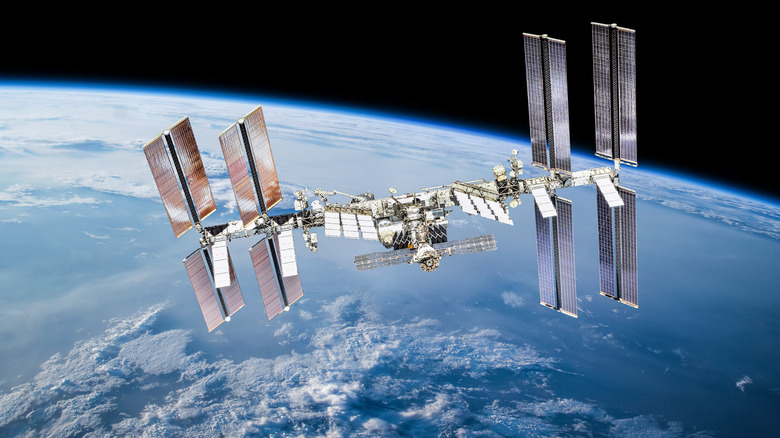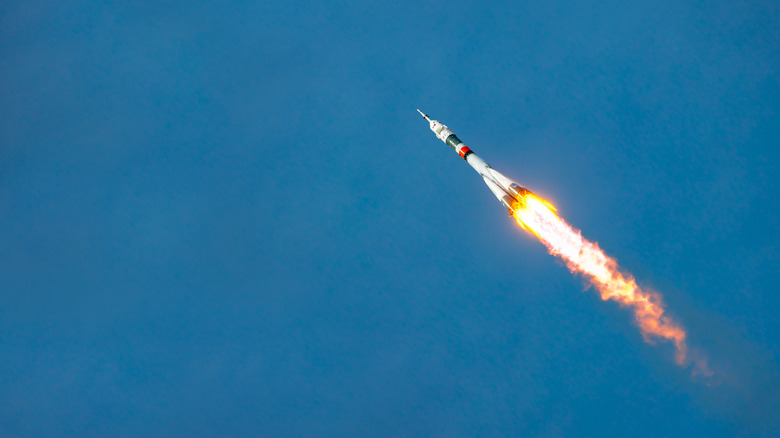The Space Junk That Once Threated The International Space Station
The International Space Station is a waypoint between the Earth's surface and a greater understanding of the larger universe that lies beyond our singular world. ISS missions have been in continuous operation since the first inhabitants arrived onboard the research platform in October 2000 (via The European Space Agency). An international coalition of astronaut researchers has maintained a constant presence in low-Earth orbit (LEO) ever since.
In the two decades that have followed, LEO has become ever more congested with satellites through the years. Live Science notes that for roughly the first five decades of space exploration (beginning in 1957 with the launch of the Sputnik probe) humans were sending between 10 and 60 new satellites into orbit per year, on average. For the last 10 years or so, this figure has exploded, with 2020 and 2021 seeing more than 1,300 and 1,400 new objects launched into a holding pattern above the Earth, respectively.
This creates a unique problem for companies and governments seeking to improve their ground-based infrastructure through the expansion of celestial communication tools. But the problem is even greater for human astronauts living in space. A collision could jeopardize lives and the critical mission that these individuals are sacrificing so much to further.
Thus far, problems for the ISS have been minimal, but in late March of 2019, that changed.
The Indian ballistic test fire that scattered debris across low-Earth orbit
In 2019, we saw an event that is rare in space technology. India test-fired a ballistic missile designed to intercept other weaponry and satellites traveling through Low-Earth orbit, according to NPR. The Indian Space Research Organisation likely destroyed a satellite called Microsat-R, which was relatively low in atmospheric space.
This resulted in a debris field of over 400 individual pieces. Directly after detonation, the International Space Station was at risk of severe impact with one or more shards of resulting junk for more than a week. Eventually, the pieces burnt up in the atmosphere, posing no long-term danger. This is a better outcome than a similar test performed by China in 2007. That satellite, which was in a higher orbit, still has pieces flying around in orbit to this day.
The ISS mission ultimately remained unharmed, and this type of posturing has remained but a blip on the radar of human efforts to bring outer space that much closer.
Controlled satellite destruction is quite common
In essence, the only way to decommission a satellite is to destroy it. These objects can't be recalled and taken apart, so the preferred means of removing one from LEO involves lowering the satellite through Earth's atmosphere to burn the space junk into harmless dust, according to NASA. Ideally, these objects are lowered under their own power and can easily be disposed of, scrubbing the atmospheric layer of debris.
Sometimes, however, satellites crash into one another or are purposefully hit by another object, as was the case in India's launch. Collisions create a debris field that may eventually burn up, but they can potentially hurl dangerous particles through the orbit indefinitely, placing ISS astronauts in harm's way and jeopardizing future launches that must contend with the space junk.
There is another, more sinister problem that may lurk in the future of space exploration though. Donald Kessler posited in 1978 that a proliferation of satellites in orbit could eventually result in a chain reaction of collisions that effectively render the space around Earth a minefield of debris, chaining humans to the surface of the planet (via The Natural History Museum). This hypothetical has been dubbed the Kessler Syndrome and is particularly relevant in an age of advancing climate change that makes space exploration all the more in vogue.
Fortunately for astronauts and those of us still on Earth, significant LEO collisions are rare and can often be managed by quick-thinking scientists.


